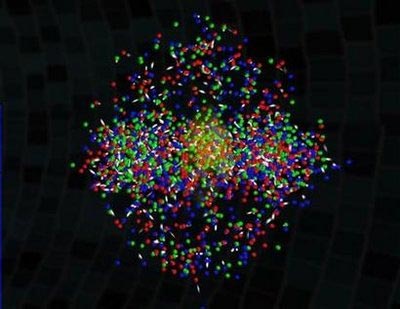Science is close to 'cooking' the 'cosmic soup'
"Cosmic soup" was a few millionths of a second after the Big Bang, in which the entire universe was in quark-gluon form and had a temperature of several trillion degrees Celsius. The study created in the laboratory a terrible temperature threshold: 4 million degrees Celsius.

Image illustrating the quark-gluon plasma cloud at Brookhaven National Energy Laboratory - Photo: Reuters
To make it easier to imagine, compare this number with familiar temperatures. The current temperature in the center of the sun is only 50 million degrees Celsius; The iron melts at 1,800 degrees Celsius and the average temperature of the universe is only 0.7 degrees Celsius. The melting temperature of protons and neutrons is 2 million degrees Celsius and the temperature in the center of an explosion superstar type two is 2 billion degrees C.
Scientists who have used the machine are relatively heavy ion colliders (abbreviated as RHIC and read "rick"). It was an accelerator and fired about 3.8 km wide particles of matter buried 3 meters below the ground, located at Brookhaven National Energy Laboratory, New York, USA.
This machine is used to let gold ions collide with each other several times to produce high temperatures.
Although scientists only maintain this temperature for a few seconds, this is the fruit of many years of research that scientists hope it will be the key to understanding how and why the universe has been formation.
"This temperature is hot enough to melt protons and neutrons," said Steven Vigdor, a Brookhaven scientist who spoke at the American Physical Society conference .
Proton and neutron are components that make up atoms. But the protons and neutrons themselves are produced by smaller particles called quarks and gluons.
Now, what scientists look for is some small irregularities that explain why matter can be formed from "cosmic soup."
Vigdor's group believed that with this temperature, they were at a time just before cosmic soup condensed into basic particles - the main ingredient that makes up the physical world today.
A few milliseconds after the Big Bang, something happened to create an imbalance to form matter and antimatter. Without this imbalance, material and antimatter are simply interacting with each other and the universe is full of energy.
This result of the scientists is not only meaningful for macro nature explaining the universe but can also be applied to life to create smaller, faster and more powerful IT devices. .
At the same time, scientists from the British National Science Institute have discovered many carbon compounds in the comet Murchison that fell to earth 40 years ago.
On BBC News, Professor Schmitt-Kopplin said: "Having this information, you can know what happens during solar system formation." He added: "Comets are like fossils. When you understand it, you are looking at the past."
It is known that Murchison comet was formed before the sun, about 4.65 billion years ago. Researchers believe it has flown through primitive clouds in the early stages of the solar system, and picked up chemical compounds.
The chemical compounds found, though not a sign of life, can help formulate the database of how life has formed on Earth.
- Why should you drink bone broth?
- He successfully created the chef robot
- 6 healthy cooking oils
- Found a thousand-year-old beef soup in a tomb
- How to use the most beneficial cooking oil
- Instructions on how to eat kimchi are not hot
- 7 tips for using healthy cooking oil
- Found soup 2,400 years old
- The habit of using oil wrongly can easily lead to liver cancer
- Regular cooking can live longer
- Chicken soup helps fight flu
- The reason why when interviewing Thomas Edison often required candidates to eat soup
 Van Allen's belt and evidence that the Apollo 11 mission to the Moon was myth
Van Allen's belt and evidence that the Apollo 11 mission to the Moon was myth The levels of civilization in the universe (Kardashev scale)
The levels of civilization in the universe (Kardashev scale) Today Mars, the sun and the Earth are aligned
Today Mars, the sun and the Earth are aligned The Amazon owner announced a secret plan to build a space base for thousands of people
The Amazon owner announced a secret plan to build a space base for thousands of people Distinguishing between severe cold, severe cold, humid cold, and dry cold: Which type of cold is the 'scariest'?
Distinguishing between severe cold, severe cold, humid cold, and dry cold: Which type of cold is the 'scariest'?  Why is it cold when the forecast is cold but it doesn't feel cold?
Why is it cold when the forecast is cold but it doesn't feel cold?  The North has long dry weather, cold at night and early morning.
The North has long dry weather, cold at night and early morning.  Global temperature records are continuously being broken
Global temperature records are continuously being broken  Humans' heat tolerance limit is not as high as we think
Humans' heat tolerance limit is not as high as we think  Your brain can heat up to 41 degrees Celsius if you think a lot
Your brain can heat up to 41 degrees Celsius if you think a lot 